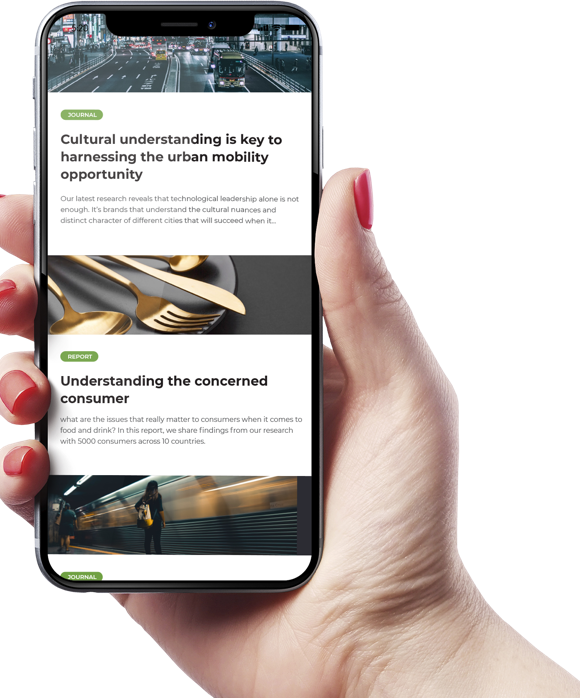Market research is critical for driving growth. It can inform strategy development, product development and marketing, setting you up for success. But it’s even more important when it comes to growing your business in countries outside of your home market.
The global market research process looks different from domestic market research and requires a different approach in order to get the best results. In this article, we’ll break down why global market research is so important, the challenges involved, and how to do it as effectively as possible.
What is global market research?
Global market research is an umbrella term for the collection and analysis of information that companies undertake in a country that isn’t their domestic market. This includes designing the study, conducting the fieldwork, analysing the data and reporting the results – and can pertain to anything from customer understanding to product development research. It differs from market research that takes place domestically, with an understanding of cultural differences being crucial to its successful execution.
Why is global market research important?
Global market research serves a number of important purposes. It helps companies understand their current or potential customers in international markets. These markets — and the people in them — are often radically different from your domestic market in many significant ways.
Failing to understand the often subtle distinctions between different global markets and gain a solid understanding of them before you launch a product can be a critical mistake that costs companies dearly.
Market research is equally important in global markets where you already operate. Here, it helps companies feel out new potential product launches and marketing campaigns, understand how numerous factors in those areas may have changed since they last conducted research, and better understand the feelings of their customers internationally.
Here are some of the main reasons to prioritize global market research:
What works well at home might fall flat abroad. You may have heard of Starbucks. It’s one of the most successful businesses in its home market of the US and is a hit with customers in many other countries across the globe. In many cities around the world, you’ll find a Starbucks almost on every corner.
In Italy, however, its presence is more limited. This is because the Italian coffee culture is profoundly different from what Starbucks offers, and the Italian public simply doesn’t have much of an appetite for the brand. The fact Starbucks has been able to gain a foothold there is an impressive achievement in itself and was only possible by significantly altering its product range — a change driven by extensive market research and collaboration with local businesses.
It allows you to improve operations and save costs. Market research helps you gain a more thorough and clear understanding of your new markets and the logistical and practical steps involved in operating there.
This allows you to get your operations right the first time, avoiding expensive mistakes and delays and streamlining the process so you can maximize your chances of overall success.
It helps you understand your competition and what you’re getting into. When it comes to new global markets and expanding into different cultures, competition is a huge factor. Market research helps you understand your competition so you can compete effectively and avoid being completely eclipsed by more popular brands.
When Best Buy attempted to move into the Chinese market, it failed miserably, closing all its stores in the country just five years later. Why did this attempt fail so badly? Ultimately, it was due to local competition.
Local, smaller Chinese electronics companies were able to offer similar products at a much lower price by paying staff less and offering fewer benefits. They also had stores in more accessible locations, catering to a more bike-based and less car-based customer population.
Had Best Buy spent more time researching the local market, they may have taken a different approach, or opted not to expand into China at all.
It allows you to identify new opportunities you may not have otherwise considered. By better understanding your market through research, you’ll be able to pinpoint new opportunities to grow, generate ideas for new products and strategies, and innovate in a way that increases your chances of success.
Get regular insights
Keep up to date with the latest insights from our research as well as all our company news in our free monthly newsletter.

The challenges of global market research
Doing market research on a global scale can be much more challenging than doing it domestically and there are many more factors and variables to consider. Much of your market research will involve speaking to customers in markets that differ from your home country. This can be difficult for many reasons:
Cultural
Some international markets will be home to a vastly different culture from your domestic market. This can make research difficult. It’s important to respect cultural norms and take these differences into account both when designing your research approach and analysing your results.
For example, in some cultures, like in China, people might be more inclined to moderate their views in a group setting, making it harder to get to the heart of an issue in a focus group, for instance. Understanding this can help you determine which methodology to choose, along with how to probe, and what to look for when you’re analysing the data.
Linguistic
Carrying out customer surveys, focus groups, in fact, anything involving interviews and questions poses obvious linguistic barriers in foreign markets. This makes global research particularly challenging. You’ll need to be able to connect with respondents and understand their views in the local language. Understanding nuances and ensuring key details aren’t lost in translation is vital, so it pays to work with native speakers to help you navigate these issues.
Logistical
Finding appropriate facilities to conduct research in a different market can be tough, particularly if you’re working on logistically challenging projects such as central location tests or taste tests, where you also need to factor in transporting products for consumers to test in person. For this, it’s important to plan ahead so you can anticipate problems and delays that might not exist in your home market.
Legal
In many parts of the world, there are laws and regulations in place that you’ll need to consider when designing your research approach. For example, Europe’s GDPR or Singapore’s PDPA.
(More information on the challenges of global market research and how to overcome them can be found in this article).
The right way to do global market research
Learn as much as possible about the regions you’re targeting
Before you start actually speaking to people and conducting market research, it’s essential to gain a thorough understanding of the region you’ll be working in. This helps avoid or mitigate many of the cultural and linguistic challenges mentioned above.
Find out as much as possible about the demographics, laws, culture, language etc of your chosen region. Publicly available resources can help with this. You may be able to access government statistics or reports that can give an illuminating view of the business landscape for companies in your industry in your chosen market and what other firms are doing. This can provide you with a solid base for your research before you even start talking to your target audience.
Design an effective research approach, rooted in your understanding of the market
You need to design a research approach that works in the context of the market. Every region of the world is different, sometimes in quite startling ways, from your domestic market. It’s important to make sure your research is designed in a way that reflects that.
This is important when you’re considering what methodology to use. For instance, you’ll need to ensure that if you’re conducting online research in China, the platform will need to be mobile-first due to the technological leapfrog the country has experienced.
(For more information about conducting online research in Asia, read our best practice guide)
It’s also important when thinking about sampling. For example, when conducting research in Vietnam, it’s essential to understand the striking cultural differences between North and South. People in the North tend to favour well-known brands, whereas those in the South are typically more open to new experiences,Make sure you think carefully about who you want to research at the outset, and if you are exploring an entire country, beware that these nuances do exist.
One of the best ways to really immerse yourself is by working with an agency that has boots on the ground, and offices in the location you want to explore. This allows you to build a research strategy that is adapted to your new market, helping you to obtain valuable insights.
Collect the data and analyse the results, bringing cultural understanding to bear
Once you’ve designed your approach, you’re ready to embark on the research itself.
There are multiple methods you can use here, such as:
- In-person interviews
- Online surveys
- Focus groups
- Online or mobile research
Each method has its own pros and cons, and the best research strategies will contain a blend of several approaches. Again, cultural understanding is really important here.
This can impact the way you approach every element of your research. For example, when writing a questionnaire in Japan, it’s important to acknowledge the cultural aversion to giving negative feedback. Here, if you used a typical 5-point Likert scale, responses might tend to end up right in the middle, giving an unhelpful result. Instead, try a 4-point scale to give a clear indication of attitudes or intent.
The next step is analysis, where again, a deep understanding of the market is critical to be able to properly interpret the results and to compare between countries. In Vietnam, for instance, it’s common for Vietnamese respondents to show high interest levels when asked about their likelihood to purchase a product. But these responses are not always realistic — many Vietnamese people will enthusiastically signal their desire to buy a product even when they don’t have the economic means to realistically do so. It’s important to cross-reference these results with other market data for a more reliable result.
Remember to account for translation or working with native speakers at this point to ensure success too.
Looking to embark on a global market research project?
Global market research is an essential process for any company looking to expand into different international markets or grow their presence in existing ones. It allows you to optimize your chances of success when trying new things in markets that may be profoundly different from your domestic market in numerous ways. It also helps you understand those markets much more keenly so you can better serve your customers there.
There are lots of variables that can make the research process for global market research projects much more challenging. It’s important to take the time to understand your new market before you begin the research process.
However, if done right, global market research can be a critical factor in mounting a successful market entry attempt, marketing campaign, or product launch allowing you to expand your brand across the world and reach entirely new levels of growth.
At Kadence, we help businesses all over the world expand into new global markets by carrying out in-depth and localised research. Contact us to find out more about how we can help you do the same.





 Sales & Marketing
Sales & Marketing Vital Strategies
Vital Strategies
 Customer Intelligence Director
Customer Intelligence Director